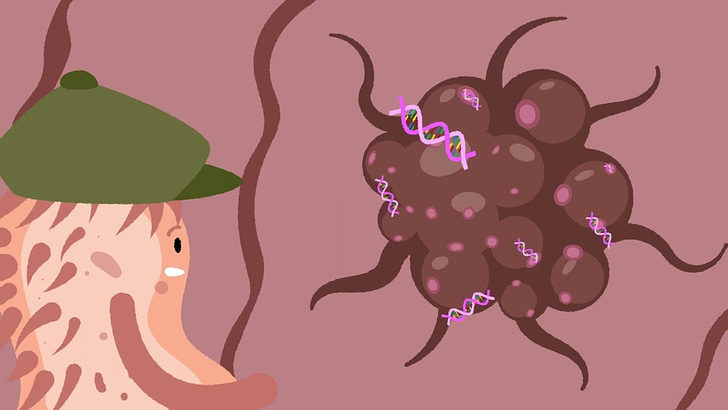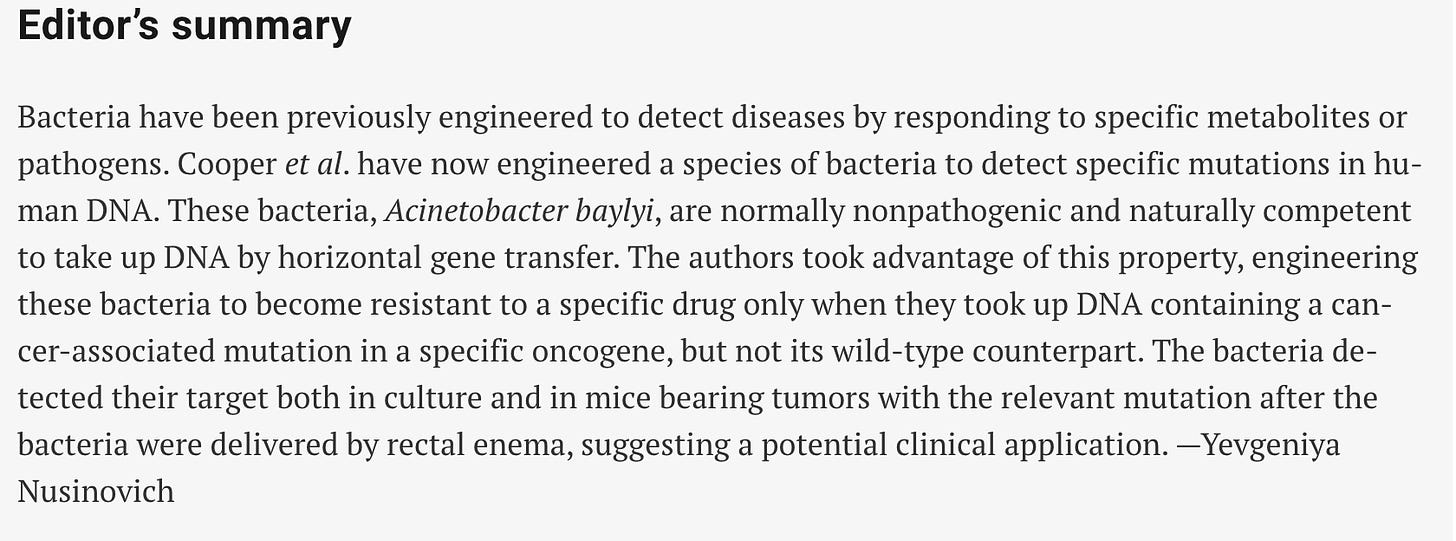I was looking at something and came upon yet another genius 2023 experiment in which the scientists genetically modified a bacterium hoping to use it as a “biosensor” to detect cancerous DNA (at what cost?)
The experiment was based on “horizontal gene transfer” in which microbes scoop up free-floating genetic material from the environment and incorporate it into their own genetic makeup. The researchers took a particular bacterial species, Acinetobacter baylyi, and genetically modified it to “contain long sequences of DNA to mirror the DNA found in a human cancer gene.” Which means, mirror, not replicate, but still. As a signaling mechanism, they programmed it to “signal” the uptake of the cancerous DNA from the environment by turning on an antibiotic resistance gene.
I am just a humble writer mourning the state of the world but it seems to me that it may not be a great idea to program a bacterium in this manner because what do you know, next thing, it could be become a new source of cancer that has not existed before! Maybe, maybe not, but how will they know?! And besides, cancer cells show up in our bodies all the time! If the world weren’t so thoroughly poisoned, and and we weren’t so thoroughly weakened by poison and stress, it wouldn’t even be a big deal that they show up! And so, if one wants to “solve cancer,” one would have to look no further than curbing the bandits who poison the world. That’s a harder task than programming a few bacteria to steal cancer DNA though, rrrriggt?
Anyway, the experiment (and study):
Horizontal gene transfer is quite common in the microbial world. Certain bacteria can salvage genes from cell-free DNA found in their immediate environment. This free-floating DNA is released when cells die. When bacteria hoover up cell-free DNA into their cells, it’s called natural competence.
So, competent bacteria can sample their nearby environment and, in doing so, acquire genes that may provide them with an advantage...
If bacteria can take up DNA, and cancer is defined genetically by a change in its DNA, then, theoretically, bacteria could be engineered to detect cancer.
Colorectal cancer seemed a logical proof of concept as the bowel is not just full of microbes, but is also full of tumour DNA when it’s struck by cancer.
Acinetobacter baylyi, a naturally competent bacterium, was chosen to be the experimental biosensor – a disease-detecting cell.
Our team modified the A. baylyi genome to contain long sequences of DNA to mirror the DNA found in a human cancer gene we were interested in capturing [← fantastic idea]. These “complementary” DNA sequences functioned as sticky landing pads – when specific tumour DNA was taken up by the bacteria, it was more likely to integrate into the bacterial genome.
It was important to integrate – hold in place – the tumour DNA. In doing so, we could activate other integrated genes, in this case an antibiotic resistance gene, as a signal for the cancer being detected.
The signal would work as follows: if bacteria could be grown on antibiotic-laden culture plates, their antibiotic resistance gene was active. Therefore they had detected the cancer.
We conducted a series of experiments in which our new bacterial biosensors and tumour cells were brought together in increasingly complex systems.
Initially, we simply marinated the biosensor with purified tumour DNA. That is, we presented our biosensor with the exact DNA it was built to detect – and it worked. Next, we grew the biosensor alongside living tumour cells. Again, it detected the tumour DNA.
Ultimately, we delivered the biosensor into live mice that either did or did not have tumours. In a mouse model of colorectal cancer, we inject mouse colorectal cancer cells into the colon, using mouse colonoscopy.
Over several weeks, the mice that were injected with cancer cells develop tumours, while the mice that were not injected serve as the healthy comparison group. Our biosensor perfectly discriminated between mice with and without colorectal cancer.
After these encouraging results, we engineered the bacteria even further. The biosensor can now tell apart single base pair changes within the tumour DNA, allowing for finely tuned precision in how it detects and targets the genes. We have named this technology CATCH: cellular assay for targeted, CRISPR-discriminated horizontal gene transfer.
CATCH holds great promise. This technology uses cell-free DNA as a new input for synthetic biological circuits, and thus for the detection of a range of different diseases, particularly infections and cancers.
However, it is not yet ready to be used in the clinic. We’re actively working on the next steps – to increase the efficiency of DNA detection, to more critically evaluate the performance of this biosensor compared to other diagnostic tests, and, of course, to ensure patient and environmental safety.
The most exciting aspect of cellular healthcare, however, is not in the mere detection of disease. A laboratory can do that.
But what a laboratory cannot do is pair the detection of disease (a diagnosis) with the cells actually responding to the disease with an appropriate treatment.
This means biosensors can be programmed so that a disease signal – in this case, a specific sequence of cell-free DNA – could trigger a specific biological therapy, directly at the spot where the disease is detected in real time.
If you have the stomach for a shallow little video designed to make the experiment “sexy,” here it is.
PS. What’s in the cards for us is a lot of immunity strengthening, methinks.
A note to readers: If you are in the position to do so, I very much encourage you to become a paid subscriber or donate. I love you in any case, but it helps A LOT, and I am in a dire need to get more donations and paid subscribers while keeping my posts free. Thank you from my heart for your support!





The "self-licking-ice-cream-cone" business strategy would be to use the GMO test bacteria yearly, while adding a little twist of their producing a few little carcinogens.
It's dead-obvious, my immediate reaction. Probably yours too, if you are reading this.
"Never give a sucker an even break", I guess.
Kinda right:
" if one wants to “solve cancer,” one would have to look no further than curbing the bandits who poison the world. That’s a a harder task than programming a few bacteria to steal cancer DNA though, rrrriggt? "
As you know, the intentional programme of depopulation by those in power (not the visible puppets) has designed chemical infiltration into most consumable products and body care products; previous health treatments mimicking the one in this post; educating doctors in debilitating drug use; chem trails in our air; and mind-entropy technolgy addiction.
Yup, to curb the bandits is a tougher job ... but until it happens we're not going to make it out of this AI shift alive.